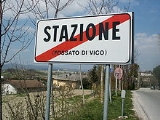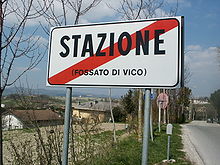
Fossato di Vico
Encyclopedia
Fossato di Vico is a town and comune
of Umbria
in the province of Perugia
in Italy
,, at 581 m above sea‑level on the middle slopes of Mount Mutali.
It lies just off the SS 3 highway, the successor to the ancient Roman Via Flaminia
, between Gualdo Tadino
(7 km to the south) and Sigillo
(6 km north); in Antiquity, a branch of the Via Flaminia may have traversed the town.

has been found in the territory of the comune, evidence of pre‑Roman habitation. Roman vestiges have been found as well, but not in quantities nor concentrations such as to warrant conclusively identifying Fossato with the ancient Helvillum, the site of which remains unknown: the other main candidate is Sigillo.
Fossato is known, however, to have been inhabited in the early Middle Ages, when it was the southernmost outpost of the Byzantine corridor, which its name seems to confirm: while fossato, meaning "ditch" in Italian, is not an uncommon placename, it is usually found on small creeks — but Fossato di Vico is on sharply sloping ground with no watercourse in the area, and it has therefore been proposed by local historians that the name is to be derived from Latin (and Byzantine Greek) fossatum, a ditch-fortified defensive work.
The specification "di Vico" was added to the name in 1862, to remember a noble of the Duchy of Spoleto
. Fossato was part of the county of Nocera in th 9th century, and after the Vico it was a possession of the Bulgarelli family, who built the current castle. In 1386 it became a free commune, which was annexed to the Papal States in 1540.
The town walls date to the late Middle Ages and would be of no particular interest were it not for a covered rampart walk capable of accommodating wide carts: it was designed for supplying the town in case of a siege. A very ruined tower at the top of the town is lovingly preserved as the oldest structure, and is said by some to be Byzantine, but without evidence.
The main churches are S. Sebastiano, the 16th‑century parish church, damaged in the Umbrian earthquake of 1997 but almost immediately restored; S. Pietro, the former parish church, medieval; S. Benedetto, also medieval, with some frescoes; and La Piaggiola, a small votive chapel of uncertain use, but likely belonging to a penitential confraternity: on its walls are to be found the best medieval frescoes in town.
Also in the plain, mention should be made of the shrine of the Madonna della Ghea.
is the frazione
of Osteria del Gatto, in the plain below, with several factories (cheese, packaging materials). An unusual aspect of the town's economy is that the municipal government has taken advantage of the winds sweeping the Cima del Mutali to contract the construction of two windmills for electrical generation; Fossato is a net exporter of electrical energy, and the installation turns a profit used for the operations of local government.
Comune
In Italy, the comune is the basic administrative division, and may be properly approximated in casual speech by the English word township or municipality.-Importance and function:...
of Umbria
Umbria
Umbria is a region of modern central Italy. It is one of the smallest Italian regions and the only peninsular region that is landlocked.Its capital is Perugia.Assisi and Norcia are historical towns associated with St. Francis of Assisi, and St...
in the province of Perugia
Province of Perugia
The Province of Perugia is the larger of the two provinces in the Umbria region of Italy, comprising two-thirds of both the area and population of the region. Its capital is the city of Perugia...
in Italy
Italy
Italy , officially the Italian Republic languages]] under the European Charter for Regional or Minority Languages. In each of these, Italy's official name is as follows:;;;;;;;;), is a unitary parliamentary republic in South-Central Europe. To the north it borders France, Switzerland, Austria and...
,, at 581 m above sea‑level on the middle slopes of Mount Mutali.
It lies just off the SS 3 highway, the successor to the ancient Roman Via Flaminia
Via Flaminia
The Via Flaminia was an ancient Roman road leading from Rome over the Apennine Mountains to Ariminum on the coast of the Adriatic Sea, and due to the ruggedness of the mountains was the major option the Romans had for travel between Etruria, Latium and Campania and the Po Valley...
, between Gualdo Tadino
Gualdo Tadino
Gualdo Tadino, an ancient town of Italy, in the province of Perugia in northeastern Umbria, on the lower flanks of Mt. Penna, a mountain of the Apennines. It is 47 km NE of Perugia and 30 km SE of Gubbio....
(7 km to the south) and Sigillo
Sigillo
Sigillo is a comune in the province of Perugia in the Italian region Umbria, located about 35 km northeast of Perugia.Sigillo borders the following municipalities: Costacciaro, Fabriano, Fossato di Vico, Gubbio.-History:...
(6 km north); in Antiquity, a branch of the Via Flaminia may have traversed the town.

History
A rare bronze plaque with a brief inscription to the Dea Cupra in the ancient Umbrian languageUmbri
The Umbri were an Italic people of ancient Italy. A region called Umbria still exists and is currently occupied by Italian speakers. It is somewhat smaller than the ancient Umbria....
has been found in the territory of the comune, evidence of pre‑Roman habitation. Roman vestiges have been found as well, but not in quantities nor concentrations such as to warrant conclusively identifying Fossato with the ancient Helvillum, the site of which remains unknown: the other main candidate is Sigillo.
Fossato is known, however, to have been inhabited in the early Middle Ages, when it was the southernmost outpost of the Byzantine corridor, which its name seems to confirm: while fossato, meaning "ditch" in Italian, is not an uncommon placename, it is usually found on small creeks — but Fossato di Vico is on sharply sloping ground with no watercourse in the area, and it has therefore been proposed by local historians that the name is to be derived from Latin (and Byzantine Greek) fossatum, a ditch-fortified defensive work.
The specification "di Vico" was added to the name in 1862, to remember a noble of the Duchy of Spoleto
Duchy of Spoleto
The independent Duchy of Spoleto was a Lombard territory founded about 570 in central Italy by the Lombard dux Faroald.- Lombards :The Lombards, a Germanic people, had invaded Italy in 568 and conquered much of it, establishing a Kingdom divided between several dukes dependent on the King, who had...
. Fossato was part of the county of Nocera in th 9th century, and after the Vico it was a possession of the Bulgarelli family, who built the current castle. In 1386 it became a free commune, which was annexed to the Papal States in 1540.
Main sights
In the plain below, two Roman bridges are extant; both relate to the Via Flaminia.The town walls date to the late Middle Ages and would be of no particular interest were it not for a covered rampart walk capable of accommodating wide carts: it was designed for supplying the town in case of a siege. A very ruined tower at the top of the town is lovingly preserved as the oldest structure, and is said by some to be Byzantine, but without evidence.
The main churches are S. Sebastiano, the 16th‑century parish church, damaged in the Umbrian earthquake of 1997 but almost immediately restored; S. Pietro, the former parish church, medieval; S. Benedetto, also medieval, with some frescoes; and La Piaggiola, a small votive chapel of uncertain use, but likely belonging to a penitential confraternity: on its walls are to be found the best medieval frescoes in town.
Also in the plain, mention should be made of the shrine of the Madonna della Ghea.
Economy
The economic engine of the comuneComune
In Italy, the comune is the basic administrative division, and may be properly approximated in casual speech by the English word township or municipality.-Importance and function:...
is the frazione
Frazione
A frazione , in Italy, is the name given in administrative law to a type of territorial subdivision of a comune; for other administrative divisions, see municipio, circoscrizione, quartiere...
of Osteria del Gatto, in the plain below, with several factories (cheese, packaging materials). An unusual aspect of the town's economy is that the municipal government has taken advantage of the winds sweeping the Cima del Mutali to contract the construction of two windmills for electrical generation; Fossato is a net exporter of electrical energy, and the installation turns a profit used for the operations of local government.
External links
- Pro Fossato (the Pro LocoPro LocoIn Italy, Pro Loco are grass-roots organizations that seek to promote some particular place, almost always a town and its immediate area; pro loco is a Latin phrase that may be roughly translated "in favor of the place"...
) - La Rumiola
- Thayer's Gazetteer of Umbria

